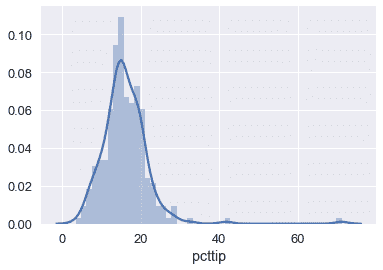# 使用程序最小化损失
> 原文:[https://www.bookbookmark.ds100.org/ch/11/gradient_basics.html](https://www.bookbookmark.ds100.org/ch/11/gradient_basics.html)
```
# HIDDEN
# Clear previously defined variables
%reset -f
# Set directory for data loading to work properly
import os
os.chdir(os.path.expanduser('~/notebooks/11'))
```
```
# HIDDEN
import warnings
# Ignore numpy dtype warnings. These warnings are caused by an interaction
# between numpy and Cython and can be safely ignored.
# Reference: https://stackoverflow.com/a/40846742
warnings.filterwarnings("ignore", message="numpy.dtype size changed")
warnings.filterwarnings("ignore", message="numpy.ufunc size changed")
import numpy as np
import matplotlib.pyplot as plt
import pandas as pd
import seaborn as sns
%matplotlib inline
import ipywidgets as widgets
from ipywidgets import interact, interactive, fixed, interact_manual
import nbinteract as nbi
sns.set()
sns.set_context('talk')
np.set_printoptions(threshold=20, precision=2, suppress=True)
pd.options.display.max_rows = 7
pd.options.display.max_columns = 8
pd.set_option('precision', 2)
# This option stops scientific notation for pandas
# pd.set_option('display.float_format', '{:.2f}'.format)
```
```
# HIDDEN
def mse(theta, y_vals):
return np.mean((y_vals - theta) ** 2)
def points_and_loss(y_vals, xlim, loss_fn):
thetas = np.arange(xlim[0], xlim[1] + 0.01, 0.05)
losses = [loss_fn(theta, y_vals) for theta in thetas]
plt.figure(figsize=(9, 2))
ax = plt.subplot(121)
sns.rugplot(y_vals, height=0.3, ax=ax)
plt.xlim(*xlim)
plt.title('Points')
plt.xlabel('Tip Percent')
ax = plt.subplot(122)
plt.plot(thetas, losses)
plt.xlim(*xlim)
plt.title(loss_fn.__name__)
plt.xlabel(r'$ \theta $')
plt.ylabel('Loss')
plt.legend()
```
让我们回到常量模型:
$$ \theta = C $$
我们将使用均方误差损失函数:
$$ \begin{aligned} L(\theta, \textbf{y}) &= \frac{1}{n} \sum_{i = 1}^{n}(y_i - \theta)^2\\ \end{aligned} $$
为了简单起见,我们将使用数据集$\textbf y=[12,13,15,16,17]$。从上一章的分析方法中我们知道,MSE 的最小$\theta$是$\text mean(\textbf y)=14.6$。让我们看看是否可以通过编写程序找到相同的值。
如果我们写得好,我们将能够在任何损失函数上使用相同的程序,以便找到$\theta$的最小值,包括数学上复杂的 Huber 损失:
$$ L_\alpha(\theta, \textbf{y}) = \frac{1}{n} \sum_{i=1}^n \begin{cases} \frac{1}{2}(y_i - \theta)^2 & | y_i - \theta | \le \alpha \\ \alpha ( |y_i - \theta| - \frac{1}{2}\alpha ) & \text{otherwise} \end{cases} $$
首先,我们创建数据点的地毯图。在地毯图的右侧,我们绘制了不同值($\theta$)的 MSE。
```
# HIDDEN
pts = np.array([12, 13, 15, 16, 17])
points_and_loss(pts, (11, 18), mse)
```

我们如何编写一个程序来自动找到$\theta$的最小值?最简单的方法是计算许多值的损失。然后,我们可以返回导致最小损失的\theta$值。
我们定义了一个名为`simple_minimize`的函数,它接受一个丢失函数、一个数据点数组和一个要尝试的$\theta$值数组。
```
def simple_minimize(loss_fn, dataset, thetas):
'''
Returns the value of theta in thetas that produces the least loss
on a given dataset.
'''
losses = [loss_fn(theta, dataset) for theta in thetas]
return thetas[np.argmin(losses)]
```
然后,我们可以定义一个函数来计算 mse 并将其传递到`simple_minimize`。
```
def mse(theta, dataset):
return np.mean((dataset - theta) ** 2)
dataset = np.array([12, 13, 15, 16, 17])
thetas = np.arange(12, 18, 0.1)
simple_minimize(mse, dataset, thetas)
```
```
14.599999999999991
```
这接近预期值:
```
# Compute the minimizing theta using the analytical formula
np.mean(dataset)
```
```
14.6
```
现在,我们可以定义一个函数来计算 Huber 损失,并将损失与$\theta$进行比较。
```
def huber_loss(theta, dataset, alpha = 1):
d = np.abs(theta - dataset)
return np.mean(
np.where(d < alpha,
(theta - dataset)**2 / 2.0,
alpha * (d - alpha / 2.0))
)
```
```
# HIDDEN
points_and_loss(pts, (11, 18), huber_loss)
```

虽然我们可以看到,$\theta$的最小值应该接近 15,但是我们没有直接为 Huber 损失找到$\theta$的分析方法。相反,我们可以使用`simple_minimize`函数。
```
simple_minimize(huber_loss, dataset, thetas)
```
```
14.999999999999989
```
现在,我们可以返回到 Tip 百分比的原始数据集,并使用 Huber 损失找到$\theta$的最佳值。
```
tips = sns.load_dataset('tips')
tips['pcttip'] = tips['tip'] / tips['total_bill'] * 100
tips.head()
```
| | 账单合计 | 提示 | 性别 | 吸烟者 | 白天 | 时间 | 大小 | PCTIP |
| --- | --- | --- | --- | --- | --- | --- | --- | --- |
| 零 | 十六点九九 | 1.01 年 | 女性 | 不 | 太阳 | 晚餐 | 二 | 5.944673 页 |
| --- | --- | --- | --- | --- | --- | --- | --- | --- |
| 1 个 | 十点三四 | 一点六六 | 男性 | No | Sun | Dinner | 三 | 16.054159 页 |
| --- | --- | --- | --- | --- | --- | --- | --- | --- |
| 二 | 二十一点零一 | 3.50 美元 | Male | No | Sun | Dinner | 3 | 16.658734 |
| --- | --- | --- | --- | --- | --- | --- | --- | --- |
| 三 | 二十三点六八 | 三点三一 | Male | No | Sun | Dinner | 2 | 13.978041 |
| --- | --- | --- | --- | --- | --- | --- | --- | --- |
| 四 | 二十四点五九 | 三点六一 | Female | No | Sun | Dinner | 四 | 14.680765 个 |
| --- | --- | --- | --- | --- | --- | --- | --- | --- |
```
# HIDDEN
points_and_loss(tips['pcttip'], (11, 20), huber_loss)
```

```
simple_minimize(huber_loss, tips['pcttip'], thetas)
```
```
15.499999999999988
```
我们可以看到,使用 Huber 损失给我们带来了\theta=15.5 美元。现在,我们可以比较 mse、mae 和 huber 损失的最小$\hat \theta 值。
```
print(f" MSE: theta_hat = {tips['pcttip'].mean():.2f}")
print(f" MAE: theta_hat = {tips['pcttip'].median():.2f}")
print(f" Huber loss: theta_hat = 15.50")
```
```
MSE: theta_hat = 16.08
MAE: theta_hat = 15.48
Huber loss: theta_hat = 15.50
```
我们可以看到,Huber 损失更接近 MAE,因为它受 Tip 百分比分布右侧的异常值影响较小:
```
sns.distplot(tips['pcttip'], bins=50);
```

## 与`simple_minimize`[¶](#Issues-with-simple_minimize)有关的问题
虽然`simple_minimize`允许我们最小化损失函数,但它有一些缺陷,使其不适合一般用途。它的主要问题是,它只使用预先确定的$theta$值进行测试。例如,在我们上面使用的代码片段中,我们必须在 12 到 18 之间手动定义$\theta$值。
```
dataset = np.array([12, 13, 15, 16, 17])
thetas = np.arange(12, 18, 0.1)
simple_minimize(mse, dataset, thetas)
```
我们如何知道检查 12 到 18 之间的范围?我们必须手动检查损耗函数的曲线图,并看到在这个范围内有一个最小值。当我们为模型增加额外的复杂性时,这个过程变得不切实际。此外,我们在上面的代码中手动指定了 0.1 的步长。然而,如果$\theta$的最佳值是 12.043,我们的`simple_minimize`函数将四舍五入到 12.00,即 0.1 的最接近倍数。
我们可以使用一个名为 _ 梯度下降 _ 的方法同时解决这两个问题。
- 一、数据科学的生命周期
- 二、数据生成
- 三、处理表格数据
- 四、数据清理
- 五、探索性数据分析
- 六、数据可视化
- Web 技术
- 超文本传输协议
- 处理文本
- python 字符串方法
- 正则表达式
- regex 和 python
- 关系数据库和 SQL
- 关系模型
- SQL
- SQL 连接
- 建模与估计
- 模型
- 损失函数
- 绝对损失和 Huber 损失
- 梯度下降与数值优化
- 使用程序最小化损失
- 梯度下降
- 凸性
- 随机梯度下降法
- 概率与泛化
- 随机变量
- 期望和方差
- 风险
- 线性模型
- 预测小费金额
- 用梯度下降拟合线性模型
- 多元线性回归
- 最小二乘-几何透视
- 线性回归案例研究
- 特征工程
- 沃尔玛数据集
- 预测冰淇淋评级
- 偏方差权衡
- 风险和损失最小化
- 模型偏差和方差
- 交叉验证
- 正规化
- 正则化直觉
- L2 正则化:岭回归
- L1 正则化:LASSO 回归
- 分类
- 概率回归
- Logistic 模型
- Logistic 模型的损失函数
- 使用逻辑回归
- 经验概率分布的近似
- 拟合 Logistic 模型
- 评估 Logistic 模型
- 多类分类
- 统计推断
- 假设检验和置信区间
- 置换检验
- 线性回归的自举(真系数的推断)
- 学生化自举
- P-HACKING
- 向量空间回顾
- 参考表
- Pandas
- Seaborn
- Matplotlib
- Scikit Learn
